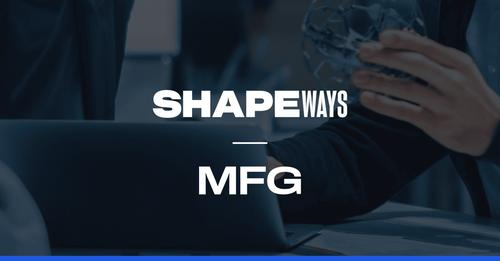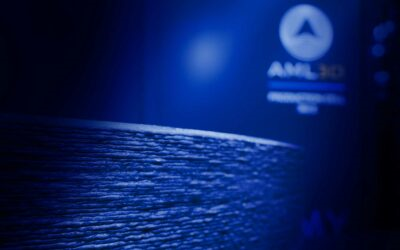Today’s 3D Printing News Briefs run the gamut from defense 3D printing and research to 3D printed modular buildings and more. Click here to read the full details!
AML3D is awarded a contract extension for US Defense Testing
Australian metal 3D printer OEM AML3D announced that it’s received a contract extension to continue alloy characterization and strength testing of Nickel-Aluminum-Bronze (NAB) 3D printing alloys for the US Navy’s submarine industrial base. The contract signed with nonprofit BlueForge Alliance is building on the positive results received from the NAB contract for testing signed in March. The contract extension is roughly A$0.37 million, (US$0.28 million) and allows AML3D to demonstrate that its proprietary ARCEMY metal AM technology meets US defense AM qualification thresholds, as well as advance the strategy to embed this technology in the US Navy’s submarine program. The work will take place at AML3D’s Adelaide facility in South Australia over the next 8-10 weeks and demonstrates the continued growth in AML3D’s US scale up strategy.
“We are excited to continue NAB alloy characterization and strength testing to support adoption of AML3D’s ARCEMY metal 3D Printing technology within the US Defence sector. This contract is further evidence of delivery against and our US scale up strategy and the ongoing development of a long-term, strategic partnership with the US Navy’s submarine industrial base,” stated AML3D Interim CEO Sean Ebert. “This second NAB alloy testing contract comes at a time of heightened interest in the potential of advanced manufacturing technologies to help meet increasing demand driven by the AUKUS alliance. AML3D’s continuing success in the US means we are increasingly well positioned to access the opportunities that will be created, as a result of the AUKUS Alliance, in the Defence markets of the US and its partners, Australia and Britain.”
Shapeways Expands Software Service Offers with MFG Materials Release

Digital Manufacturing Leader Shapeways Holdings, Inc. MFG Materials was launched to extend its software offerings. The new feature, immediately available to current premium subscribers, offers a variety of raw materials to manufacturers at discounted rates—based on material and quantity ordered—thanks to Negotiations and strategic partnerships with the top raw material suppliers. MFG Materials is therefore able to provide 100% ROI to customers. This is great news as the market for industrial raw material like aluminum, steel, plastics and other metals is booming. The new MFG Materials platform offers a great value proposition. Shapeways also has a low cost monthly membership that is ideal for manufacturers who want to access this new service.
“We’re committed to supporting our manufacturers. With the launch of MFG Materials, we’re taking a practical step toward helping them save on raw material costs. Depending on the volume, suppliers can realize a sound return on investment by purchasing their raw material inventory through us,” said Greg Rothman, GM of Software for Shapeways.
“The growth trajectory of the industrial materials market is impressive. MFG Materials’ mission is to help its customers seize these enormous opportunities. Our economies of scale not only make these markets more accessible but also enable significant cost savings. This boosts competitiveness and profitability for manufacturers, fueling growth in the U.S. manufacturing sector.”
AMGTA Commissioned Survey Highlights the Binder Jet’s Sustainability

The Additive Manufacturer Green Trade Association (AMGTA) has announced the preliminary results of a study, “Comparative Life-Cycle Assessment: Comparison of Casting vs Binder Jetting for an Industrial Part,” conducted by the Yale School of the Environment (YSE) in partnership with Desktop Metal and Trane Technologies. Binder jetting has a 38% lower greenhouse gas emission rate than traditional metal casting. This is primarily due to the reduced energy consumption during printing. Researchers in the study compared binder jetting to casting to determine the relative manufacturing impact. Some other important takeaways include the importance of the manufacturing facility’s energy mix to the impact on GHG emissions, and that a redesign for lightweighting the scroll chiller via a lattice-type structure wouldn’t necessarily lead to further emissions reductions.
“We’re delighted to have another piece of independent, third-party research that validates how binder jetting is a greener approach to metal part production. Harmful emissions from traditional metal manufacturing need to be lowered with innovative technology approaches, but manufacturers need sound data—not greenwashing—to make good choices about how they produce their metal products,” said Jonah Myerberg, Chief Technology Officer at Desktop Metal. “This new study from Yale, Trane Technologies and AMGTA demonstrates what our team at Desktop Metal has long believed based on our hands-on experience: binder jetting is a greener way to manufacture metal parts.”
The full results of this survey will be released in early 2024, following a peer-review process.
Fraunhofer IAPT’s AM Density Determination Benchmark Study

Speaking of studies, Fraunhofer IAPT commissioned an independent benchmark study, “Analysis of measurement methods for density determination in additive manufacturing,” about the available AM density determination technologies—a critically important property because of its impact on a 3D printed component’s performance and structural integrity. Manufacturers can accurately measure density to determine reliability and quality, as well as identify defects or porosity in the material. They can also ensure the AM process runs optimally. The study compared the cost-effective automated density determination provided by Dimensionics Density with micrographs, computed Tomography (CT), or the manual Archimedes technique. It found that this method is the most useful, especially when density measurements are required frequently and quickly. Micrographs require a great deal of manual work and destroy the 3D-printed part, while CT is expensive and requires expert operators. In addition, the 3D images it produces are limited in pore size. The Archimedes method, while easier to use than the others, can be negatively impacted by environmental conditions, precision of the experimental procedure, and more, so it’s less accurate. The study reports that Dimensionics Density’s solution is the only one that’s traceable to a recognized standard, has a much higher repeatability, lower fluctuations, shorter measurement time, and more, all of which proves its value.
“We are extremely encouraged that the Fraunhofer IAPT report recognised the advantages of the automated density determination process that we produce. Our process uses the Archimedes technique, as mentioned above, in combination with modern automated technology. The samples are placed into a special component carrier that has openings at the bottom. The component carriers are moved through the system using an axis robotic arm and then lowered precisely and centrally onto the scales. A lift-out rack is mounted on the scales, which raises the component through the openings of the component carrier. This automated handling prevents human error in measurement because the parts are placed exactly the same on each scale. The scales have been designed to be vibration-proof. In addition, all ambient conditions such as temperature, air pressure, and water temperature, are recorded via climate sensors, and their influence on the measurement result is taken into account directly in the evaluation algorithm when determining the density,” said Philipp Pruesse, Head of Sales at Dimensionics Density.
3D-printed Modular Buildings in North Rhine-Westphalia

Additive construction optimizes production processes and allows for the fabrication of individual concrete components and geometries that conventional formwork can’t achieve. The 3D-printed modular building in Beckum (North Rhine-Westphalia) was constructed using sustainable building materials. Located near a “biker railway,” with a large storage room and open, covered entrance, the structure offers enough space to store tools and sports equipment, and features an elliptical façade that curves out and runs into the inner shell’s vertical structure; a design only possible with 3D printing. Planning office MENSE KORTE partnered with Röser GmbH, which specializes in 3D printed prefabricated parts, and MC-Bauchemie, an international developer and manufacturer of construction chemical products, to successfully complete the project in 18 months.
The goal was to create a printed building with the desired properties (i.e. material with thixotropic behavior), but also majorly reduces CO₂ emissions. The team conducted many material tests to find the right material composition, and used MENSE KORTE’s special 3D dry mortar MC-PowerPrint GeCO₂, with blast furnace slag and fly ash as a binding agent instead of cement; alternative binders made of industrial by-products can save around 70% of CO₂ emissions in comparison to cement. The individual prefab parts were printed at Röser’s site and then transported over 500 kilometers on a closed inboard loader, which negates the reduction of CO₂ emissions but was necessary to stress test the parts. The prefabricated pieces were then transported to the construction site where they were easily placed onto a slab of precast concrete and attached with anchors in a matter of hours.
Subscribe to Our Email Newsletter
Receive information and offers about 3D printing from third-party vendors.



